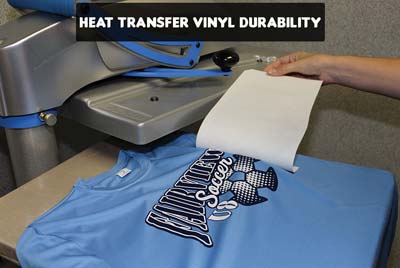
Adding vinyl to any project is the perfect way to make cool, fun summer crafts!
Perhaps you have a t-shirt or a tote bag lying around that your granny sewed?
Or a pillow that you bought from the store?
Even plain-o’-socks start to look super spunky when you create beautiful designs on it with heat transfer vinyl and personalize it for yourself!
The world of vinyl crafting is addicting, fun and tricky all at the same time. And you have to prepare for some pretty CRAZY outcome as well!
For instance, the stylish logo you printed on your apron yesterday might start fading after a few washes. Or that superman logo on your kid’s favorite T-shirt might have a crack in the middle after few months and leave him feeling powerless!
Does that mean heat transfer vinyl isn’t that reliable?
Absolutely NOT!
In fact, it’s quite the opposite!
If you follow some tricks and tips, a vinyl material might even outlive the garment itself!
Let’s talk about heat transfer vinyl durability in detail and give you some secret recipes that will keep your prints from getting peeled, cracked or wrinkled.
What Is Heat Transfer Vinyl?
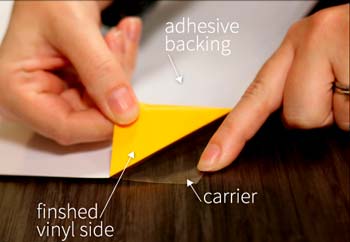
Heat Transfer Vinyl aka HTV in short is one kind of special vinyl polymer. It is used to create designs on fabrics or garments for decorative or promotional purposes.
The apparel vinyl can be cut, weeded and placed on top of a T-shirt or a bag or other types of clothing products with the help of a hot iron or heat press. For this reason, many people also know this process as Iron-On Transfer as well.
The HTVs are available in different size of rolls or pre-cut sheets in the market. Although these sheets are made in single colors, you will find different variations, such as patterned, glitter, glow-in-the-dark and even 3D puff HTVs!
Read More: Vinyl T-Shirt Printing vs Screen Printing. We compare these two printing methods and share their pros and cons to help you choose a process that’s right for you!
What Is Heat Transfer Vinyl Made Of?
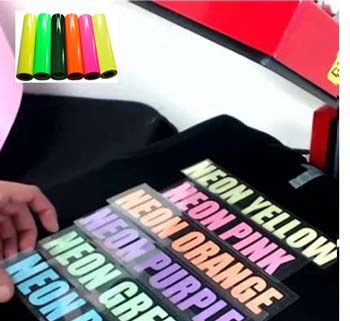
Heat transfer vinyl is made of either Polyurethane (PU) or Poly Vinyl Chloride (PVC) material.
Once unboxed, you will see HTV in the form of a roll or sheets, which have a plastic covering on the back. This covering side appears a bit shinier and it’s called the “Carrier”.
On the other side of the carrier, the HTV features an adhesive backing that activates itself when you use heat on it. The adhesive backing bonds permanently with the fabric and transfer the desired design on your favorite piece of clothing!
Read our related article on How to Use a Heat Press Machine. If you’re new to heat pressing, this guide is for you! We cover everything you need to know to get started.
How Long Does Heat Press Vinyl Last?
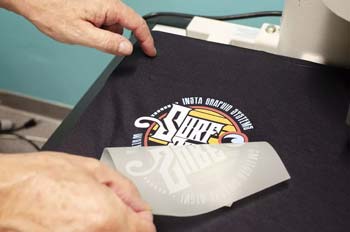
A pressed T-shirt looks pretty cool with its creative logos and funky words written on it, doesn’t it?
And the good news is, the material is quite durable and lasts for a good time if you know how to maintain its qualities!
There are a few reasons behind it. For starters, Vinyl is a pretty strong material that can handle even your messy fabric handling habits. The material doesn’t shrink after washing nor deform in any way when exposed to heat or moisture.
However, as we explained earlier, the heat pressing technique relies on the adhesiveness of the vinyl on the fabric. So, over time, the material will break down at some point.
Usually, with good care and precaution, a heat-pressed T-shirt may last for 50 washes or so! Ergo, the vinyl may stay intact while the fabric itself gets worn out!
To help you have an easier and better understanding, we will talk about how to make HTV, which is otherwise known as iron-on transfer, to last longer on fabric.
How To Make Iron On Transfers Last Longer?
Let The Fabric Settle
Just after getting your printing done, you have to give your fabric some time to settle in before start wearing. We recommend waiting at least 24 hours before wearing/ironing/handling/washing/trying it out. This will help the adhesive to get dry faster and bond to the fabric properly.
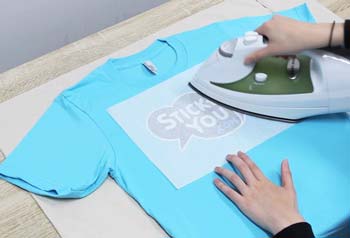
Turn Your Clothes Inside-Out
During the wash, turn your clothes/pillowcase inside-out.
This simple action gives a garment the extra layer of protection it needs and keeps it safe while in the washing machine. It also helps prevent the damage from being rubbed with other clothes during the washing period.
Set The Water Temperature Right
Hot?
Nah!
When it comes to vinyl, the colder the better!
So, when you wash a T-shirt or handkerchief with HTV prints, choose cold or at least medium-warm temperature that doesn’t exceed 178-Degree Fahrenheit. Using higher temperatures than this might result in peeling/cracking your favorite prints permanently.
Use Mild Detergent
Use mild detergent to wash printed clothes. Better yet, make a homemade mixture of your own!
Mix water and mild soap in a container and use a soft, non-abrasive tool to clean vinyl clothes.
Hang-Dry
Vinyl doesn’t like high heat. So, it’s best to let the fabric air-dry itself. Just lay them flat on a drying rack and the cloth will be ready to use in a few hours!
What To Avoid?
Soaking? Please No!
Soaking loosens the adhesive property of the vinyl.
You may not notice it at first. But after 2-3 washes, the print may start to fade away. When the vinyl starts to peel off from its first corner, the rest of the prints come off like a tornado!
To avoid this type of incident, it’s best to put your T-shirt into the water just as you are about to start the wash.
Do NOT Iron
Vinyl doesn’t like heat.
Did I mention this before? Oh! well, it’s worth saying twice, then!
The direct heat from an ironing machine is too much for printed cloth. That’s why it’s a good practice to turn the shirt inside out before ironing. Also, put a protective layer between the fabric and the iron for the best result.
Avoid Using Fabric Softener
Any kind of fabric softener used on your printed garment will end up stripping up your shirt altogether!
It will make your vinyl garment stick to other garments as well as lose its adhesive property. So, it’s recommended to ditch all sorts of fabric softener while washing iron-on clothes.
Also know: Easy way to soften your shirt.
Vinyl Reacts With Bleach Too!
Bleach is another enemy for vinyl!
If you are thinking about cleaning that yellow spot on your T-shirt (From the spicy Chicken Curry you ate last night, yum!) by dousing it with bleach, DON’T!
Bleach contains harmful chemicals that react with vinyl and make it lose its strength. If you really need to do it anyway, try spot cleaning method instead of bleaching the whole thing for a better result.
Dry-Cleaning Is A Big NO-NO
Although vinyl has some pretty good resistive properties, its adhesive system isn’t that much up to the mark!
We strongly recommend NOT to put your vinyl-printed T-shirt in the dryer. Try natural drying instead to keep it away from any direct source of heat.
Read More: Cost of Sublimation vs Vinyl. Here’s everything you need to know to choose between sublimation and vinyl!
Can You Mend Heat Transfer Vinyl Wrinkle?
If you have followed our advice up to this point, then your clothes should be good to go for a long time to come!
However, things hardly go as planned, doesn’t it?
If you already got your vinyl T-shirt all wrinkled up by mistake, then the best thing you can do is to remove it altogether and do a fresh heat-press on it.
To remove the wrinkles, follow the instructions down below:
- Set your iron machine at the lowest temperature.
- Turn the cloth inside-out and start ironing it.
- Wait for a few minutes to give the vinyl some time to cool off and then peel it away while it’s still a bit hot.
- Now that your T-shirt doesn’t have any prints on it, you can put it in the drier machine to let it dry a bit.
- Once the T-shirt has warmed up a bit, use your hands to smooth it out.
- Done? Now just lay it flat on the table and come back once it’s all cool and fresh as new!
Next time, make sure the fabric you are going to use is washed and dried properly so that it doesn’t shrink after applying the vinyl on it.
Read our related article on How to Remove HTV From a Shirt! Mistakes happen, but they can be fixed with these DIY solutions!
How To Fix Vinyl Coming Off Shirt?
No matter how carefully you handle the T-shirt with your favorite animation printed on it, there is still a chance the vinyl may start to peel off!
The good news is, if it’s just a small portion, then there’s still hope after all.
Let’s see what we can do to fix that thing right up!
- Take your iron machine and set it to the highest temperature setting.
- Locate the place where the prints are peeling off and place a piece of paper on top.
- Using only the corner of the ironing machine, press on that particular place gently.
- Keep repeating the above step until you notice the print getting stuck to your T-shirt again. We recommend doing this for at least 20 seconds to make sure it’s well and secure.
Frequently Asked Questions

1. Should I Wash My Clothes Before Using Iron-On Transfer?
Answer: No, that’s probably not a good idea.
The detergent might mess up the transfer process. The oil from the detergent might interfere with the adhesive property and weaken its properties.
2. Can I Heat Press On My Old T-Shirts?
Answer: Yes, you can.
In that case, we recommend pressing the shirt for 5-6 seconds before starting to print vinyl on it. This action will help remove all the excess moisture from your cloth.
3. Adhesive Vinyl Or Iron-On Vinyl Transfer-Which One Is Better?
Answer: Iron-on vinyl, of course!
There’s no competition, really. The adhesive kinds are like stickers that aren’t permanent and will come off at the slightest disturbance.
4. Is There Any Way To Fix A Mistake I Made While Printing?
Answer: Yes, there is actually!
You will need an embossing gun and tweezer for this purpose.
Use the embossing gun to heat up the back part of the print. Once it’s all heated up, use the tweezer to peel off any mistake you made while doing the transferring process.
5. Why Does Some Vinyl Start Peeling Just After Being Printed?
Answer: The problem lies in the ironing process.
If you keep ironing the fabric for a too long or too short time, the design won’t get imprinted properly. Depending on the temperature setting, you might have to adjust the timing accordingly.
Final Words
Along with talking about heat transfer vinyl durability, we have tried to cover a lot of tips and tricks, troubleshoots and gave solutions on how to fix them in this article.
With proper care and maintenance, iron-on transfer ends up lasting longer than the fabric itself, at times!
Hopefully, our article has inspired you to dust off your cutting machine and try out some cool HTV projects on your own! Trust me, once you get you started, there’s a big possibility you will get hooked forever!
Oh, and more thing.
We have mentioned some of the basic instructions in this article to keep your prints intact for the longest time.
However, each manufacturer always adds some special care instruction for its product. Don’t forget to note them down if you want a fantabulous result in the end!
That’s it for now. See you next time.
Happy crafting to all of you!
Relevant article to read: